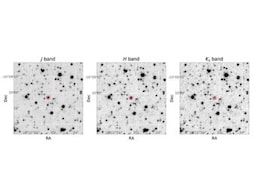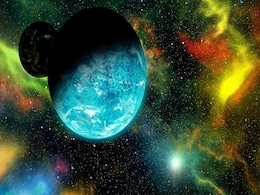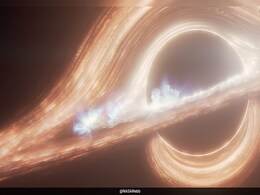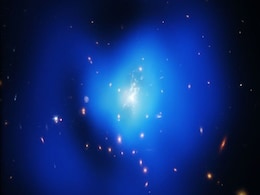James Webb
- All
- News
- Videos
- Web Stories
-

Astronomers Detect Methane in the Atmosphere of the Nearest T Dwarf Star to Earth
- Saturday April 12, 2025
- Written by Gadgets 360 Staff
Astronomers have detected methane in the nearest known T dwarf, offering new insight into its atmospheric composition. The study further highlights that the carbon abundance in the planet is estimated to be -1.5 dex, while the effective temperature could be around 1,000 K. The author of the paper further revealed that the low metallicity of the T ...
-
 www.gadgets360.com
www.gadgets360.com
-

JWST Captures Unseen Details of Exoplanets in HR 8799 and 51 Eridani Systems
- Thursday April 3, 2025
- Written by Gadgets 360 Staff
The James Webb Space Telescope (JWST) has captured groundbreaking images of exoplanets in the HR 8799 and 51 Eridani systems. By modifying its coronagraphs, astronomers allowed more starlight to pass through, revealing clearer planetary details. The study, published in The Astrophysical Journal Letters, highlights the first successful detection of ...
-
 www.gadgets360.com
www.gadgets360.com
-

Two New Exoplanets Found Orbiting a Star in Draco Constellation
- Wednesday April 2, 2025
- Written by Gadgets 360 Staff
Astronomers have identified two exoplanets, TOI-1453 b and TOI-1453 c, orbiting a star 250 light-years away in Draco. The planets, a super-Earth and a sub-Neptune, were detected using NASA’s TESS satellite and the HARPS-N spectrograph. TOI-1453 b is a rocky planet orbiting close to its star, while TOI-1453 c is twice Earth’s size and may have a...
-
 www.gadgets360.com
www.gadgets360.com
-

James Webb Space Telescope Reveals a Stunning Einstein Ring in Hydrus
- Wednesday April 2, 2025
- NDTV
A striking new image from the James Webb Space Telescope reveals an Einstein ring in the Hydrus constellation. The phenomenon occurs when a massive foreground galaxy bends light from a hidden background galaxy, forming a near-perfect ring. This effect, predicted by Einstein’s theory of general relativity, helps astronomers study galaxies from the...
-
 www.gadgets360.com
www.gadgets360.com
-

James Webb Telescope Captures Neptune’s Auroras in Stunning Detail
- Monday March 31, 2025
- Written by Gadgets 360 Staff
The James Webb Space Telescope has provided the first-ever direct images of Neptune’s auroras, revealing surprising details about the ice giant’s atmosphere. Unlike auroras on Earth, Jupiter, or Saturn, Neptune’s auroras appear across unexpected locations due to its tilted and offset magnetic field. Scientists also detected the presence of H...
-
 www.gadgets360.com
www.gadgets360.com
-

Astronomers "Astonished" After Oxygen Detected In Most Distant Galaxy
- Thursday March 20, 2025
- World News | Agence France-Presse
Oxygen has been detected in the most distant galaxy ever discovered, surprised astronomers said Thursday, offering further evidence that stars in the early universe matured far quicker than had been thought possible.
-
 www.ndtv.com
www.ndtv.com
-

Alien Life May Survive on Planets Orbiting White Dwarfs, Study Finds
- Wednesday March 26, 2025
- Written by Gadgets 360 Staff
New research explores the possibility of alien life on planets orbiting white dwarfs. While these stellar remnants cool over time, their shrinking habitable zones may still allow biological processes like photosynthesis and UV-driven abiogenesis to occur. A model assessing a planet's energy reception over seven billion years indicates that life-sus...
-
 www.gadgets360.com
www.gadgets360.com
-

NASA's Webb Captures First Direct Images Of Carbon Dioxide Outside Solar System
- Tuesday March 18, 2025
- Science | Edited by Ritu Singh
This finding provides compelling evidence that the giant planets in HR 8799 formed through core accretion, a process similar to the formation of Jupiter and Saturn.
-
 www.ndtv.com
www.ndtv.com
-

James Webb Space Telescope Captures Hourglass Nebula LBN 483 in Stunning Detail
- Tuesday March 18, 2025
- Written by Gadgets 360 Staff
The James Webb Space Telescope has captured unprecedented details of LBN 483, a nebula located 650 light-years away. The striking hourglass-shaped structure results from outflows driven by a forming binary star system. JWST’s infrared imaging and ALMA’s radio observations reveal how stellar winds, jets, and magnetic fields sculpt the nebula ove...
-
 www.gadgets360.com
www.gadgets360.com
-

Water May Have Formed in the Universe 100 Million Years After Big Bang
- Thursday March 13, 2025
- Written by Gadgets 360 Staff
A new study suggests water formed in the universe just 100–200 million years after the Big Bang, much earlier than previously estimated. Researchers examined ancient supernovas to understand how oxygen combined with hydrogen to create water. If confirmed, these findings could change perspectives on when the conditions for life first emerged. The ...
-
 www.gadgets360.com
www.gadgets360.com
-

James Webb Space Telescope Observes Mysterious Rogue Planet-Like Object
- Thursday March 6, 2025
- Written by Gadgets 360 Staff
The James Webb Space Telescope has captured new insights into SIMP 0136, a planetary-mass object floating freely around 20 light-years away. This celestial body, possibly a rogue planet or a brown dwarf, has puzzled astronomers for years. JWST’s infrared observations have revealed intricate cloud layers, temperature shifts, and potential chemical...
-
 www.gadgets360.com
www.gadgets360.com
-

Astronomers Detect Flares From Milky Way's Black Hole
- Thursday February 20, 2025
- World News | Edited by NDTV News Desk
Using the James Webb Space Telescope, astronomers captured the most detailed look at this black hole activity
-
 www.ndtv.com
www.ndtv.com
-

JWST Identifies Cooling Gas in Phoenix Cluster, Unlocking Star Formation Process
- Thursday February 20, 2025
- Written by Gadgets 360 Staff
The James Webb Space Telescope has detected the missing cooling gas in the Phoenix Cluster, a galaxy cluster located 5.8 billion light-years away. Researchers used the Mid-Infrared Instrument (MIRI) to identify gas at around 540,000 degrees Fahrenheit trapped in cavities within the cluster. This discovery resolves a long-standing mystery of how sta...
-
 www.gadgets360.com
www.gadgets360.com
-

James Webb Space Telescope Captures Sagittarius A Emitting Continuous Flares in Milky Way’s Core
- Thursday February 20, 2025
- Written by Gadgets 360 Staff
The James Webb Space Telescope has captured Sagittarius A*, the Milky Way’s supermassive black hole, emitting flares continuously. These bursts, varying in intensity and duration, have been observed over multiple sessions. Scientists believe the activity may be linked to magnetic interactions within the accretion disk. The phenomenon appears rand...
-
 www.gadgets360.com
www.gadgets360.com
-

Astronomers Detect Methane in the Atmosphere of the Nearest T Dwarf Star to Earth
- Saturday April 12, 2025
- Written by Gadgets 360 Staff
Astronomers have detected methane in the nearest known T dwarf, offering new insight into its atmospheric composition. The study further highlights that the carbon abundance in the planet is estimated to be -1.5 dex, while the effective temperature could be around 1,000 K. The author of the paper further revealed that the low metallicity of the T ...
-
 www.gadgets360.com
www.gadgets360.com
-

JWST Captures Unseen Details of Exoplanets in HR 8799 and 51 Eridani Systems
- Thursday April 3, 2025
- Written by Gadgets 360 Staff
The James Webb Space Telescope (JWST) has captured groundbreaking images of exoplanets in the HR 8799 and 51 Eridani systems. By modifying its coronagraphs, astronomers allowed more starlight to pass through, revealing clearer planetary details. The study, published in The Astrophysical Journal Letters, highlights the first successful detection of ...
-
 www.gadgets360.com
www.gadgets360.com
-

Two New Exoplanets Found Orbiting a Star in Draco Constellation
- Wednesday April 2, 2025
- Written by Gadgets 360 Staff
Astronomers have identified two exoplanets, TOI-1453 b and TOI-1453 c, orbiting a star 250 light-years away in Draco. The planets, a super-Earth and a sub-Neptune, were detected using NASA’s TESS satellite and the HARPS-N spectrograph. TOI-1453 b is a rocky planet orbiting close to its star, while TOI-1453 c is twice Earth’s size and may have a...
-
 www.gadgets360.com
www.gadgets360.com
-

James Webb Space Telescope Reveals a Stunning Einstein Ring in Hydrus
- Wednesday April 2, 2025
- NDTV
A striking new image from the James Webb Space Telescope reveals an Einstein ring in the Hydrus constellation. The phenomenon occurs when a massive foreground galaxy bends light from a hidden background galaxy, forming a near-perfect ring. This effect, predicted by Einstein’s theory of general relativity, helps astronomers study galaxies from the...
-
 www.gadgets360.com
www.gadgets360.com
-

James Webb Telescope Captures Neptune’s Auroras in Stunning Detail
- Monday March 31, 2025
- Written by Gadgets 360 Staff
The James Webb Space Telescope has provided the first-ever direct images of Neptune’s auroras, revealing surprising details about the ice giant’s atmosphere. Unlike auroras on Earth, Jupiter, or Saturn, Neptune’s auroras appear across unexpected locations due to its tilted and offset magnetic field. Scientists also detected the presence of H...
-
 www.gadgets360.com
www.gadgets360.com
-

Astronomers "Astonished" After Oxygen Detected In Most Distant Galaxy
- Thursday March 20, 2025
- World News | Agence France-Presse
Oxygen has been detected in the most distant galaxy ever discovered, surprised astronomers said Thursday, offering further evidence that stars in the early universe matured far quicker than had been thought possible.
-
 www.ndtv.com
www.ndtv.com
-

Alien Life May Survive on Planets Orbiting White Dwarfs, Study Finds
- Wednesday March 26, 2025
- Written by Gadgets 360 Staff
New research explores the possibility of alien life on planets orbiting white dwarfs. While these stellar remnants cool over time, their shrinking habitable zones may still allow biological processes like photosynthesis and UV-driven abiogenesis to occur. A model assessing a planet's energy reception over seven billion years indicates that life-sus...
-
 www.gadgets360.com
www.gadgets360.com
-

NASA's Webb Captures First Direct Images Of Carbon Dioxide Outside Solar System
- Tuesday March 18, 2025
- Science | Edited by Ritu Singh
This finding provides compelling evidence that the giant planets in HR 8799 formed through core accretion, a process similar to the formation of Jupiter and Saturn.
-
 www.ndtv.com
www.ndtv.com
-

James Webb Space Telescope Captures Hourglass Nebula LBN 483 in Stunning Detail
- Tuesday March 18, 2025
- Written by Gadgets 360 Staff
The James Webb Space Telescope has captured unprecedented details of LBN 483, a nebula located 650 light-years away. The striking hourglass-shaped structure results from outflows driven by a forming binary star system. JWST’s infrared imaging and ALMA’s radio observations reveal how stellar winds, jets, and magnetic fields sculpt the nebula ove...
-
 www.gadgets360.com
www.gadgets360.com
-

Water May Have Formed in the Universe 100 Million Years After Big Bang
- Thursday March 13, 2025
- Written by Gadgets 360 Staff
A new study suggests water formed in the universe just 100–200 million years after the Big Bang, much earlier than previously estimated. Researchers examined ancient supernovas to understand how oxygen combined with hydrogen to create water. If confirmed, these findings could change perspectives on when the conditions for life first emerged. The ...
-
 www.gadgets360.com
www.gadgets360.com
-

James Webb Space Telescope Observes Mysterious Rogue Planet-Like Object
- Thursday March 6, 2025
- Written by Gadgets 360 Staff
The James Webb Space Telescope has captured new insights into SIMP 0136, a planetary-mass object floating freely around 20 light-years away. This celestial body, possibly a rogue planet or a brown dwarf, has puzzled astronomers for years. JWST’s infrared observations have revealed intricate cloud layers, temperature shifts, and potential chemical...
-
 www.gadgets360.com
www.gadgets360.com
-

Astronomers Detect Flares From Milky Way's Black Hole
- Thursday February 20, 2025
- World News | Edited by NDTV News Desk
Using the James Webb Space Telescope, astronomers captured the most detailed look at this black hole activity
-
 www.ndtv.com
www.ndtv.com
-

JWST Identifies Cooling Gas in Phoenix Cluster, Unlocking Star Formation Process
- Thursday February 20, 2025
- Written by Gadgets 360 Staff
The James Webb Space Telescope has detected the missing cooling gas in the Phoenix Cluster, a galaxy cluster located 5.8 billion light-years away. Researchers used the Mid-Infrared Instrument (MIRI) to identify gas at around 540,000 degrees Fahrenheit trapped in cavities within the cluster. This discovery resolves a long-standing mystery of how sta...
-
 www.gadgets360.com
www.gadgets360.com
-

James Webb Space Telescope Captures Sagittarius A Emitting Continuous Flares in Milky Way’s Core
- Thursday February 20, 2025
- Written by Gadgets 360 Staff
The James Webb Space Telescope has captured Sagittarius A*, the Milky Way’s supermassive black hole, emitting flares continuously. These bursts, varying in intensity and duration, have been observed over multiple sessions. Scientists believe the activity may be linked to magnetic interactions within the accretion disk. The phenomenon appears rand...
-
 www.gadgets360.com
www.gadgets360.com
















![Gadgets 360 With Technical Guruji: Did You Know? [April 6, 2024] Gadgets 360 With Technical Guruji: Did You Know? [April 6, 2024]](https://c.ndtvimg.com/2024-02/mpconh58_did-you-know_640x480_10_February_24.jpg?downsize=245:163)





